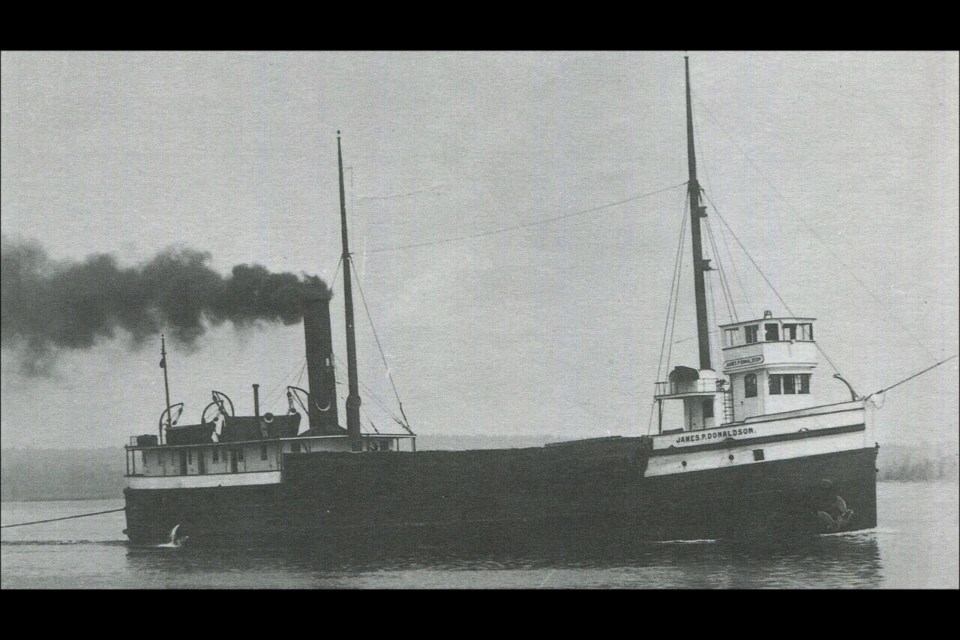THUNDER BAY — It was totally by accident that Thunder Bay divers Robert Farrow and Chris Aegard came upon the wreck of the James P. Donaldson.
The two were cruising Lake Superior on Saturday when they stumbled upon the wreck of the ship that was scuttled off the Welcome Islands after a devastating fire in 1923.
The James P. Donaldson was 185 feet long.
It was used to shuttle wet wheat to the Paterson elevator on the Kam River to dry out.
Farrow describes it as a spectacular find.
He has a fascination for historical objects, saying some people might call them junk, but he sees them as treasures because they are "part of how we built this country."
The James P. Donaldson was built in Marine City, Michigan in 1880, and purchased by Lakehead-based Paterson Steamships Ltd. in 1921.
According to the Fort William Times-Journal, just two years later the ship suffered a major fire in port, so it was towed onto Lake Superior and scuttled.
Farrow said he and Aegard had been cruising the area between Thunder Cape and Angus Island when they spotted the vessel.
"We were just tooling around, doing the sightseeing kind of thing. I leave the fishfinder turned on, and it picked something up. We circled back and put the side-scan [side imaging sonar] out and ran back over it."
He said he realized immediately what the image was, because he was very familiar with a photo of its sinking, and "it fit perfectly, with the burnt back and the stern mast," which is still standing.
"The lifeboat is still there. It looks like everything was just left on the boat after it burned, and they brought it out there. It's pretty cool."
Farrow spent a lot of time in the 1990s looking for the wreckage.
"It's been elusive. Where I found it, it's like 'Why did they dump it here?' " he wondered.
He calls it a "pretty historical find," noting that the James P. Donaldson was only the second boat acquired by Paterson Steamship Lines.
Numerous other ships were scuttled in Lake Superior in the early part of the 20th century.
Farrow says the remains of about ten smaller vessels including barges and tugs were sunk around the Welcome Islands.
Many others are also said to lie offshore from Thunder Bay in an area dubbed the Graveyard of Ships, including the third vessel acquired by Paterson.
Farrow said the first, the DR Van Allen, was sunk as a dock on the northside waterfront.
He said you can still see the outline of its hull, and "it's pretty neat finding all three vessels."
Farrow plans to return to where the Donaldson lies to drop a camera down to check for visibility and any hazards such as nets before considering a dive.
He said it's clear the boiler is still on the ship, and he's curious to see if the engine is still aboard as well.
Thunder Country Diving owner Wally Peterson said there are photos of the Donaldson being scuttled, but because there was no frame of reference such as an island or the Sleeping Giant, it was hard to pinpoint its location.
"All we knew is that the people on the "A" island of the Welcome Islands, where a lighthouse stood, could see it sinking," Peterson said.
He's not aware of it being discovered previous to this weekend, despite a social media suggestion that it was found in 1992.
If that's the case, Peterson said, "whoever found it kept it very, very quiet and never told anyone."
He believes discoveries such as the Donaldson can have beneficial spinoff effects such as promoting the Thunder Bay area for tourism.
"The Graveyard of Ships is in very dirty water. This may be cleaner water, and may be diveable by recreational divers. Maybe the submarine on the Octantis might be interested in viewing it," he speculated.
Viking Cruise LInes' Viking Octantis, which is making seven excursions to the Thunder Bay area this season, is equipped with two submersibles.
